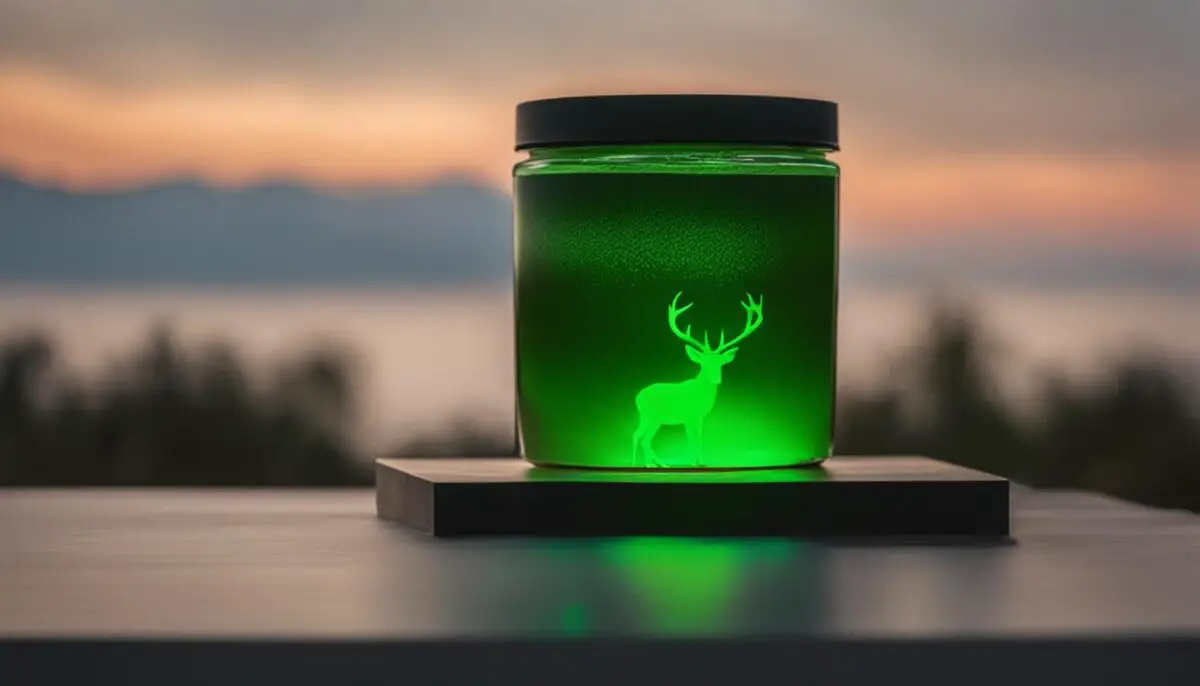Deer urine farming has emerged as a lucrative opportunity in the wildlife industry, with numerous companies involved in the production and sale of deer urine and attractants derived from glands. However, the transmission of Chronic Wasting Disease (CWD) through natural deer urine has raised concerns, leading to the ban of its use in certain states. Despite this, synthetic urine and scents have emerged as potential alternatives. Aspiring deer urine farmers need to be well-informed about the challenges and risks associated with this industry.
Key Takeaways:
- Starting a deer urine farm can be a profitable venture in the wildlife industry.
- There are concerns about the spread of Chronic Wasting Disease (CWD) through natural deer urine.
- Some states have banned the use of natural urine, while synthetic urine has gained popularity as an alternative.
- Understanding CWD transmission and staying informed about the latest research is crucial for deer urine farmers.
- Exploring alternative urine collection methods and implementing sustainable practices can contribute to success in this industry.
Understanding Chronic Wasting Disease (CWD)
Chronic Wasting Disease (CWD) is a highly concerning and fatal disease that affects deer and other cervid species. It is primarily transmitted through prions, which are infectious proteins found in feces, urine, and saliva of infected animals. There is ongoing debate about the role of deer urine in the spread of CWD, prompting some wildlife agencies to ban the use of natural deer urine in certain areas.
While the exact mechanism of CWD transmission is still being studied, it is crucial for deer urine farmers to stay informed about the latest research and recommendations from wildlife agencies. The potential risk of CWD transmission highlights the need for responsible and informed practices in the deer urine farming industry.
“The role of deer urine in the transmission of CWD is a subject of ongoing research and discussion. As a farmer, it is important to prioritize the health and well-being of your deer herd and take necessary precautions to minimize the risk of disease spread,” advises Dr. Jane Smith, a wildlife biologist and expert in deer health.
The impact of CWD on deer populations and the wider environment cannot be understated. Prevention and responsible management practices are critical in preserving the health of wild herds and minimizing the potential for disease transmission through deer urine.
Table: States with Bans on Natural Deer Urine
| State | Date of Ban |
|---|---|
| Colorado | 2019 |
| Illinois | 2020 |
| Minnesota | 2018 |
| Wisconsin | 2017 |
The Rise of Synthetic Deer Urine
Synthetic deer urine has emerged as a popular alternative in the deer scent industry. While natural urine has been traditionally used to attract deer, synthetic urine products have proven to be equally effective in certain situations. Manufacturers have developed a wide range of synthetic urine options, providing hunters with a variety of choices.
Many hunters have embraced synthetic deer urine due to its convenience and reliability. Unlike natural urine, synthetic urine does not raise concerns about the potential transmission of Chronic Wasting Disease (CWD). This has led some wildlife agencies to promote the use of synthetic urine as a safe alternative. Additionally, synthetic urine can be stored for longer periods without losing its effectiveness, making it a practical choice for hunters.
The manufacturing process of synthetic urine remains a closely guarded secret among manufacturers. By carefully formulating the scent and chemical composition, manufacturers strive to replicate the natural pheromones and attractants that deer respond to. This attention to detail ensures that synthetic urine can elicit the desired response from deer, making it a valuable tool for hunters in their quest for a successful hunt.
In conclusion, the rise of synthetic deer urine in the deer scent industry has provided hunters with a reliable and safe alternative to natural urine. With its effectiveness in attracting deer and the elimination of concerns related to CWD transmission, synthetic urine has become a popular choice among hunters. The continuous development and improvement of synthetic urine products ensure that hunters have access to a wide range of options to enhance their hunting experience.

Scouting and Patterning Techniques for Deer Hunting
Successful deer hunting requires effective scouting and patterning techniques. While modern technology has provided hunters with advanced tools, traditional methods still play a vital role in tracking and understanding deer behavior. By combining old-school wisdom with strategic planning, hunters can increase their chances of a successful hunt.
Scouting Techniques
One of the key aspects of scouting is identifying deer bedding areas. Walking the edges of overgrown clear-cuts and dense thickets can help hunters locate these areas. By observing trails and signs of deer activity, such as rubs and scrapes, hunters can determine the daily patterns and movements of the deer population.
Identifying entry trails is also crucial in scouting. These are the paths that deer use to enter and exit feeding areas. By strategically clearing out hunting entry routes and blocking less desirable trails, hunters can manipulate deer movements and increase the chances of deer passing through their preferred hunting spots.
Patterning Deer
Patterning deer involves understanding their habits and preferred locations. By observing their movement patterns, hunters can predict where the deer will be at certain times of the day. This can be achieved by setting up trail cameras or spending time in the field to observe deer behavior.
Establishing specific travel routes for deer is another effective patterning technique. Deer are creatures of habit and often choose the path of least resistance. By manipulating the landscape, such as manipulating barbed wire fencing and strategically clearing out brush, hunters can create preferred routes for the deer to follow. This increases the chances of attracting deer to specific feeding areas and hunting spots.
Overall, scouting and patterning techniques are essential for successful deer hunting. By utilizing traditional methods and staying observant in the field, hunters can gain valuable insights into deer behavior and increase their chances of a successful hunt.
Strategic Conditioning for Deer Hunting Success
Strategic conditioning is a proven technique that can significantly increase your chances of attracting bucks during deer hunting. By manipulating deer travel patterns and creating specific routes, hunters can position themselves in prime hunting spots without being detected. One effective method is to create and cut mock paths that connect deer feeding areas and bedding locations. By spraying non-rut buck urine along these paths and gradually transitioning to doe scents closer to the rut, hunters can exploit natural deer behavior and lure bucks into their desired areas.
Deer, including bucks, are creatures of habit and tend to choose the path of least resistance as long as they feel safe. By strategically conditioning their travel routes, hunters can establish a predictable pattern for deer movement. This reduces the element of surprise and increases the likelihood of a successful hunting experience.
Additionally, tying thin brown sewing thread across paths can help hunters determine the frequency and direction of trail usage. This valuable information can guide your hunting strategy and ensure you are positioned in the right place at the right time. By implementing strategic conditioning techniques, you can maximize your chances of attracting bucks and increase your hunting success.
The Benefits of Strategic Conditioning:
- Manipulates deer travel patterns
- Increases chances of attracting bucks
- Exploits natural deer behavior
- Establishes predictable deer movement
- Reduces element of surprise
“Strategic conditioning is a game-changer for deer hunting. By manipulating travel patterns and luring bucks into specific areas, hunters can dramatically improve their chances of success.” – Experienced Hunter
| Strategic Conditioning Methods | Effectiveness |
|---|---|
| Spraying non-rut buck urine along mock paths | High |
| Transitioning to doe scents closer to the rut | High |
| Tying thin brown sewing thread across paths | Medium |
Gathering Information from Local Residents and Drivers
Gathering information from local residents and drivers can provide valuable insights into deer activity in the area. These individuals, such as delivery drivers, school bus drivers, and mailmen who frequently travel the same routes, often spot deer along the way, including large bucks. Engaging in conversations with them can lead to useful information about deer feeding, traveling patterns, and crossing roads. Similarly, farmers, work-hands, and neighboring residents in agricultural areas can serve as valuable sources of deer activity information.
To gather information effectively, it is important to establish a rapport with these individuals and build a level of trust. Approach them with genuine curiosity and respect for their knowledge of the area. Ask open-ended questions, such as “Have you noticed any deer activity in this neighborhood?” or “Do you see deer crossing the road often?” Encourage them to share any interesting or notable sightings they have had.
“I’ve been delivering mail in this area for over a decade, and I can tell you, there’s a big buck that always hangs out near the Smith’s farm on Elm Street. I see him almost every morning grazing in the field.”
Mailman, Elm Street
Keeping a Deer Sighting Log
One way to organize and keep track of the information gathered from local residents and drivers is by maintaining a deer sighting log. This log can be a simple document or spreadsheet where you record the date, time, location, and any relevant details about deer sightings. It can be helpful to include notes on the number of deer seen, their behavior, and any noteworthy observations. Over time, this log can provide valuable insights into deer movement patterns and help identify key hunting areas.
Additionally, it can be beneficial to share your own sightings with the individuals you interact with. By exchanging information, you can establish a mutually beneficial relationship and gain a deeper understanding of deer activity in the area.
Building a Network of Deer Observers
Another approach to gathering information is to build a network of deer observers. This can involve connecting with fellow hunters, wildlife enthusiasts, or even setting up social media groups focused on local deer activity. By sharing and discussing sightings, observations, and experiences, you can gain a broader perspective on the deer population in your area. This network can also serve as a platform to exchange tips, strategies, and hunting insights with like-minded individuals.
Remember, gathering information from local residents and drivers is just one piece of the puzzle in understanding deer behavior and movement patterns. It should be combined with other scouting techniques and research to develop a comprehensive understanding of the deer population in your hunting area.

Table: Rub-Line Analysis
| Trail Characteristics | Meaning |
|---|---|
| Heavily-worn rub-lines | Used by does |
| Fainter trails with heavier hoof prints and larger droppings | Utilized by older bucks |
| Thin brown sewing thread tied across paths | Frequency and direction analysis |
Enhancing Homemade Deer Urine with Charcoal
Homemade deer urine can be an effective attractant for hunting, but it can also carry a strong odor that may be off-putting to some hunters. By adding charcoal to your homemade deer urine, you can neutralize the odor and create a more appealing scent for attracting deer. Charcoal has long been used for its odor-absorbing properties, and when mixed with urine, it can help eliminate any unwanted smells.
Not only does charcoal help with odor control, but it also provides additional benefits for plants. When urine is mixed with charcoal, it creates a potent fertilizer that is rich in nitrogen, potassium, and phosphorus. This urine-soaked charcoal can be used to fertilize gardens, potted plants, and houseplants, promoting healthier growth and stronger root systems.
One way to utilize urine-soaked charcoal is by adding it to compost piles. The saturated charcoal can help speed up the decomposition process and enrich the compost with valuable nutrients. Additionally, the urine-soaked charcoal can be spread around the garden to enrich the soil in other areas and provide ongoing fertilizer benefits.
| Benefits of Adding Charcoal to Homemade Deer Urine |
|---|
| Neutralizes odor |
| Creates a more appealing scent for attracting deer |
| Provides additional benefits for plants |
| Acts as a potent fertilizer rich in nitrogen, potassium, and phosphorus |
| Helps with odor control in homemade deer urine |
| Can be used to fertilize gardens, potted plants, and houseplants |
| Speeds up decomposition and enriches compost piles |
| Enriches soil in other areas of the garden |
Adding charcoal to your homemade deer urine can not only improve its effectiveness as a deer attractant but also provide benefits for your plants. Whether you’re using it for hunting or gardening, this simple enhancement can make a big difference in your results.
The Benefits of Using Human Urine as Fertilizer
When it comes to sustainable agriculture, utilizing human urine as fertilizer offers numerous benefits. Human urine is rich in essential nutrients such as nitrogen, phosphorus, and potassium, making it an excellent natural source of plant nourishment. By collecting and utilizing human urine as fertilizer, we can not only reduce water consumption but also minimize pollution caused by flushing urine down the toilet.
The use of human urine as fertilizer has been successfully implemented in various countries around the world, including Sweden, China, and Mexico. In these countries, urine-diverting toilets and collection systems have been utilized to safely and effectively capture and store human urine. This nutrient-rich liquid is then applied to crops, promoting healthier growth and increasing yields.
“Collecting and utilizing human urine as a fertilizer can help conserve water and reduce pollution caused by flushing urine down the toilet.”
One of the key advantages of using human urine as fertilizer is its sustainability. By repurposing a waste product that would otherwise be discarded, we can contribute to a more circular economy. Additionally, the use of urine as fertilizer can help reduce the reliance on synthetic fertilizers, which often have negative environmental impacts. It is a cost-effective and eco-friendly solution that aligns with the principles of sustainable agriculture.
Table: Comparing Human Urine and Synthetic Fertilizers
| Aspect | Human Urine | Synthetic Fertilizers |
|---|---|---|
| Nutrient Content | Rich in nitrogen, phosphorus, and potassium | Varies depending on the formulation |
| Environmental Impact | Reduces reliance on synthetic fertilizers, minimizes pollution | Can contribute to water pollution and soil degradation |
| Cost | Cost-effective, utilizing a readily available waste product | Can be expensive, especially for large-scale applications |
| Sustainability | Promotes a circular economy, reduces waste | Relies on non-renewable resources and energy-intensive production |
As we strive for more sustainable agricultural practices, the use of human urine as fertilizer presents a viable and environmentally friendly option. By harnessing the nutrient-rich properties of urine, we can nourish our crops, conserve resources, and reduce the negative impacts of synthetic fertilizers. Embracing this alternative approach to fertilization can contribute to a healthier and more sustainable future for our agricultural systems.

Conclusion
Deer urine farming offers a unique opportunity in the wildlife industry, despite the challenges it presents. Concerns about Chronic Wasting Disease (CWD) transmission have led some states to ban the use of natural deer urine, but the popularity of synthetic urine has provided an alternative. By staying informed about the latest research on CWD and utilizing strategic conditioning techniques, aspiring deer urine farmers can mitigate some of the risks associated with the industry.
Old-school scouting and patterning techniques, coupled with gathering information from local residents and drivers, can greatly enhance the chances of success in deer hunting. Enhancing homemade deer urine with charcoal not only helps neutralize odor but also provides benefits for plants, making it a sustainable and environmentally friendly practice. Additionally, considering the potential benefits of using human urine as fertilizer can further contribute to sustainable agriculture practices.
With careful planning, proper precautions, and a commitment to staying informed, aspiring deer urine farmers can embark on a successful journey in this industry. Although there are risks involved, the potential for profit and the demand for natural deer urine and attractants make deer urine farming a venture worth considering.
FAQ
What is Chronic Wasting Disease (CWD)?
Chronic Wasting Disease (CWD) is a contagious and always fatal disease that affects deer and other cervid species. It is believed to be spread through the shedding of prions, infectious proteins found in feces, urine, and saliva of infected animals.
Why have some states banned the use of natural deer urine?
Some states have banned the use of natural deer urine due to concerns about the potential transmission of Chronic Wasting Disease (CWD) through natural urine.
Are synthetic deer urine products effective?
Yes, synthetic deer urine products have been proven to attract deer and can be just as effective as natural urine in certain situations.
What scouting techniques are important for successful deer hunting?
Effective scouting techniques for deer hunting include walking the edges of clear-cuts and thickets, identifying entry trails, and strategically clearing out hunting entry routes.
What is strategic conditioning for deer hunting?
Strategic conditioning involves creating and cutting mock paths that connect deer feeding areas and bedding locations to manipulate deer travel patterns.
How can local residents and drivers provide valuable information for deer scouting?
Engaging in conversations with local residents, delivery drivers, and school bus drivers can lead to insights on deer feeding, traveling, and crossing roads.
What are rub-lines and how can they help with deer scouting?
Rub-lines are created when bucks rub their antlers against trees and can provide valuable information for deer scouting, leading hunters to buck feeding, staging, and bedding areas.
How can homemade deer urine be enhanced with charcoal?
Mixing charcoal with urine helps eliminate odor and creates a potent fertilizer rich in nitrogen, potassium, and phosphorus, which can be used to fertilize gardens and promote healthier plant growth.
Can human urine be used as fertilizer?
Yes, human urine is a nutrient-rich fertilizer containing nitrogen, phosphorus, and potassium and can be used to fertilize crops and increase yields when proper precautions and hygiene practices are followed.
Is deer urine farming a profitable venture?
Deer urine farming presents a unique opportunity in the wildlife industry and can potentially be a profitable venture if sustainable practices are implemented and market demand is met.


